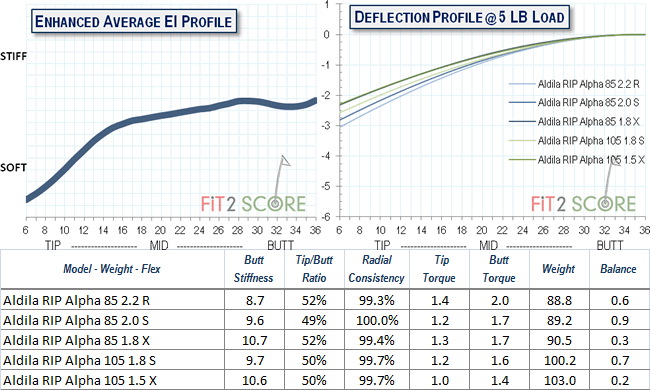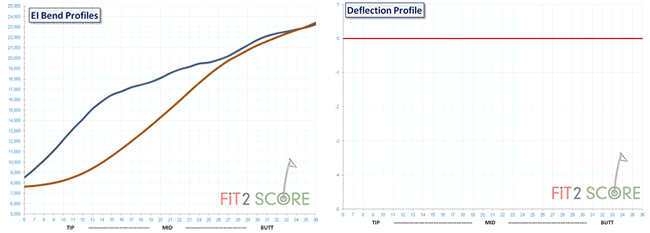Aldila RIP Alpha Hybrid
By Russ Ryden, A Golf Digest America’s 100 Best Clubfitter
Fit2Score, Dallas Fort Worth, Texas
This is not a new shaft from Aldila, it was released several years ago. It was the pioneering release of Reverse Interlaminar Placement in Aldila shafts. It has been used in all subsequent shafts. It has never been clear to me exactly what was done. Their illustrations show bias plies at both the inner and outer wraps of the shaft. Most premium shafts over the last few years have adapted to some variation of this layup design.
What brought the RIP to my attention was the release of the KBS Tour V and the Nippon Modus3 Tour 130 designs. Both have a long stable butt and mid with a rapid loss of stiffness toward the tip in the high tip section of the shaft. When working on my Hybrid fitting system I saw this pattern in the RIP Alpha Hybrid.
 I secured a few more review samples from Aldila and took a hard look at the model. It has really low tip torque numbers and excellent radial consistency. If you are familiar with the table from other reviews you will notice that the format of the balance column has changed. It is now expressed in terms of the midpoint of the shaft. A positive number indicates the balance is above the midpoint, a negative number below the midpoint. This makes it easier to see the amount of counterbalance build into a shaft. What we see in the Alpha is a ‘balanced’ shaft.
I secured a few more review samples from Aldila and took a hard look at the model. It has really low tip torque numbers and excellent radial consistency. If you are familiar with the table from other reviews you will notice that the format of the balance column has changed. It is now expressed in terms of the midpoint of the shaft. A positive number indicates the balance is above the midpoint, a negative number below the midpoint. This makes it easier to see the amount of counterbalance build into a shaft. What we see in the Alpha is a ‘balanced’ shaft.
In future reviews you will see deflection profiles The EI profiles I have been using may cause some confusion and consternation when looking at the charts. You can see unusual peaks and valleys is many designs. This is not how the shaft bends. That is how the designer tailored the stiffness of the shaft to create a bend profile. In this illustration you can see increasing and decreasing load applied to the EI numbers and watch how the shaft bends in response to loading and unloading.
The Aldila RIP Hybrid shaft profile, what one shaft company tour rep explained as convex vs concave when discussing two popular models, is seeing a lot of play recently. I found an example of two shafts with similar butt and tip stiffness and in my new bend modeling software applied increasing tip loads to the shafts to help me envision how these two extremes compare to each other. 
This is new methodology, I am not aware of any other software implementation of load modeling based on EI profiles. What we clearly see here is the mid shaft stiffness creating a propensity for a lower launch. What you also see is the importance of matching the load you apply to a shaft. Shafts that are too stiff for you barely bend, giving you a boardy feeling. Shafts that are too soft, bend too much. As they recover from applied load during the reduced acceleration that happens just before impact, they add too much variation to head speed and orientation. That is why being properly fit into a shaft is a huge factor in shot dispersion.
When warm weather returns to Dallas we will get to reaction from the local golf professionals comparing the feel of these two designs.


